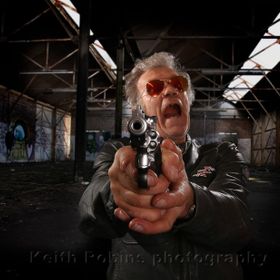
keithrobins
FollowViews
226
Likes
Awards
Great Shot
Outstanding Creativity
Top Choice
Superb Composition
Absolute Masterpiece
Magnificent Capture
Superior Skill
Top Ranks
Same photographer See allBehind The Lens
Behind The Lens
Location
I have a large shed which is totally light-tight. Two saw haorses and an old flush panelled door for a table. Black backdrop draped over a lewngth of UPVC pipe laid in a short piece of plastic guttering with a long bolt slotted into the top of a hollow light stand from the sixties.Time
Sunniest day of the year and I was staying out of the heat, in the darkened shed.Lighting
An LED pocket torch with part used batteries was aimed at each part of the picture from a distance of only 50mm. Keeping the light on the move during each four second exposure prevents my hand or the torch from being recorded. One of the 20 exposures was of just the laces on the centre boot. Another was of the left set of laces while yet another was of the black leather rim, firsat the centre boot and then the left one. The old film camera took three exposures and the map another four.Equipment
Canon 70D set to F22 at 100 ISO, four second shutter speed with 25-105mm L series lens, Manfrotto tripod. White balance is set to the flash icon as the LED torch records best at that balance.Inspiration
Harold Ross runs a workshop in the states and I accidentally came across so of the work done by his students while on a course and all they use is torch light and multiple exposures. Absolutely stunning work was posted up on Harold's blog and I was hooked. How hard could it be to take similar photos? This was my first attempt and I can say right now that I was lucky in geting this good a shot right off the cuff.Editing
With twenty exposures I would need layers and layer masks to merge all the shots. I only have Photoshop CS 1 so it did struggle a bit with the almost 2 gig file size. I opened a general image of around 10 seconds to give me a base, turned down the opacity to 30% then clicked on the Eye icon to view the next layer above. Add a layer mask, fill it with black and paint in the small area lit with the torch in that layer. By holding down the alt key and clicking on the layer palette mask thumbnail I can quickly view the exact area to paint before clicking again to hide that layer under a black mask. Sounds long winded in theory but in practise it takes around one minute per layer. Sometimes the opacity requires taking down to achieve a pleasing tone. Then on to the next layer above and do it all over again.In my camera bag
Canon 70D, 24-104mm L series which is my favourite lens of all time, 10-20mm wide angle Sigma zoom, Canon 580EX flash, six sets of Energiser rechargable batteries, a set of three iShoot flash triggers and two transmitters in case one goes down. A DIY remote shutter release, a Hannel giga T pro 11 radio release. A set of Roscoe flash filter - you never know when you might need a 1/2 CTO filter to help light a sunset portrait. There is also a DIY big bounce for my flashgun shaped out of a paint bucket lid which I use for weddings, portraits, flowers and macro work. A couple flashgun shields which velcro onto the side of my flash to help guide the light where it required.Feedback
Finding a load of old junk which is related in some way is harder than you might think. Old garden tools, or electrical repairs tools and odd bits of wire plus a soldering iron. Or maybe something to do with sewing, knitting, fishing, baseball, etc. any sort of hobby has an assortment of bits which can make up a good still-life. Then there is the angle and distance from which you light each of the multiple layers. Does the light bounce off a shiny surface straight into the camera lens? Is there any texture that will look good if the torch is angled along it or from the rear? Keep that light moving. Light each part of the image using several techniques before moving on the illuminate the next part of your set. Your memory will gradually improve the more set ups you photograph. Being able to leave you tripod in front of the sep up is very usful should you need to retake and relight a vital part of you still-life. Lastly, I only ever use Jpegs otherwise the overall file size would clog my computer. Have fun, then share your pleasure on-line.
























